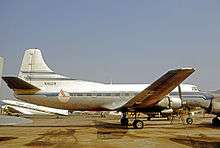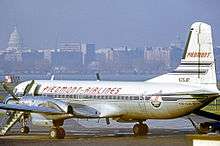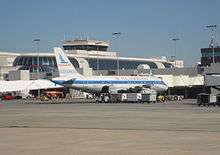Piedmont Airlines (1948–89)
| |||||||
| Founded | 1948 | ||||||
|---|---|---|---|---|---|---|---|
| Ceased operations | 1989 (integrated into USAir). | ||||||
| Operating bases | Winston-Salem, North Carolina | ||||||
| Hubs |
Charlotte/Douglas International Airport Baltimore/Washington International Airport | ||||||
| Secondary hubs |
James M. Cox Dayton International Airport; Syracuse Hancock International Airport | ||||||
| Subsidiaries | Piedmont Regional Airlines | ||||||
| Fleet size | 12 different types of aircraft | ||||||
| Destinations | 95 (Sept 1988) | ||||||
| Company slogan | A Model of How Good an Airline Can Be | ||||||
| Headquarters | Winston-Salem, North Carolina | ||||||
| Key people |
Thomas Henry Davis - Founder William R. Howard - CEO | ||||||
| Website | www.jetpiedmont.com | ||||||
Piedmont Airlines (IATA: PI, ICAO: PAI, Call sign: PIEDMONT) was a major airline in the United States which operated from 1948 until it was acquired by and merged into USAir in 1989. Its headquarters were at One Piedmont Plaza in Winston-Salem, North Carolina, a building that is now part of Wake Forest University.[1][2]
In April 1989, shortly before it merged into USAir, Piedmont had 22,000 employees.[1] In September 1988, it flew to 95 airports from hubs in the eastern United States; its commuter and regional affiliates flew turboprop aircraft via code sharing agreements to 39 more.
History
The company that would become Piedmont Airlines was founded by Thomas Henry Davis (1918 – April 22, 1999[3]) in Winston-Salem, North Carolina in 1940, when Davis purchased Camel City Flying Service and changed the name to Piedmont Aviation.[4] Piedmont originally operated as an airplane repair service and a training school for pilots in the War Department Civilian Pilot Training Program. In 1944, Davis filed an application to run a passenger flight service in the southeast. After several years of lobbying government agencies and fighting legal challenges from other airlines, Piedmont received authorization on January 1, 1948. The first flight, from Wilmington, North Carolina to Cincinnati, was on February 20, 1948.[5]
Davis grew up in Winston-Salem, North Carolina.[6] As a child, he loved airplanes and often used his allowance to take flying lessons. He took pre-med classes at the University of Arizona.[3][6] At the same time, he worked as a part-time flight instructor.
Foundation

Like most airlines before deregulation, Piedmont did not have hubs. The airline flew jets to small airports and connected unlikely city pairs with jet flights: Kinston, North Carolina, and Florence, South Carolina; Roanoke, Virginia, and Asheville, North Carolina; Lynchburg, Virginia, and New York City's LaGuardia Airport; Chicago's O'Hare International Airport and Bristol/Kingsport/Johnson City, Tennessee; and Winston-Salem, North Carolina, to Lynchburg, Virginia.
Its early routes stretched from Wilmington, North Carolina, northwest to Cincinnati, Ohio, with numerous intermediate stops. Early routes were operated with Douglas DC-3 aircraft.
Growth
| Revenue passenger traffic, in millions of passenger-miles (scheduled flights only)[7] | ||||||||||||||
|---|---|---|---|---|---|---|---|---|---|---|---|---|---|---|
|




Piedmont started with Douglas DC-3s and later added the Fairchild F-27 and Martin 4-0-4; Fairchild Hiller FH-227B flights started in 1967 and NAMC YS-11A flights in May 1969. In August 1953 it scheduled flights to 26 airports and by May 1968 the number of airports served had grown to 47.
Like other Local Service airlines, Piedmont was subsidized; in 1962, its operating "revenues" of $18.2 million included $4.8 million "Pub. serv. rev."[8]
The jet age
Piedmont's first jet flights took off in March 1967 and were operated with 92-seat Boeing 727-100s flying such routes as Atlanta (ATL) - Asheville (AVL) - Winston-Salem (INT) - Roanoke (ROA) - New York LaGuardia Airport (LGA). Boeing 737-200s arrived in 1968 and larger Boeing 727-200s were added from 1977. One 727 that Piedmont bought from Northwest Orient Airlines was the same aircraft that was hijacked by D. B. Cooper. Fokker F28 Fellowship twin jets were also added to the fleet as well as new Boeing 737-300, 737-400 and 767-200ER jetliners.
Route expansion
In 1955, the network extended from Cincinnati and Louisville east to the coast from Norfolk to Myrtle Beach. At the end of 1978, still under U.S. route regulation, Piedmont's routes reached north to New York, west to Denver, Colorado, and south to Miami, Florida. Flights to Dallas/Ft. Worth began in 1979 followed by Houston in 1980 and New Orleans in 1982.[9] In 1984, Los Angeles and San Francisco were added to the route system followed by Minneapolis/St. Paul in 1985, Montreal and Ottawa in Canada in 1986 and Seattle in 1987.[10] By 1988, the airline was serving Phoenix and San Diego in addition to a new international destination being Nassau, Bahamas[11] and by 1989 was operating flights to Bermuda as well as nonstop service between Los Angeles and Baltimore, Charlotte, Dayton and Tampa; nonstop service between San Francisco and Charlotte, Dayton and Kansas City; nonstop service between Phoenix and Baltimore and Charlotte; and nonstop service between Seattle and Charlotte[12] Shortly before the merger with USAir in 1989, Piedmont was operating connecting passenger hubs located at Baltimore (BWI), Charlotte (CLT), Dayton (DAY) and Syracuse (SYR).[13] The Syracuse operation was the smallest hub in the route system and was previously a hub operated by Empire Airlines prior to its acquisition by Piedmont.[14]
Deregulation
Following airline deregulation in the late 1970s, the airline grew rapidly and developed a hub at Charlotte/Douglas International Airport (CLT) in Charlotte, North Carolina. Piedmont bought Empire Airlines, based in Utica, New York, in 1985 which brought additional Fokker F28 Fellowship jets into the fleet.[1] Passenger-miles for the merged airline in 1987 were almost nine times Piedmont's RPMs in 1977.
Later hubs included Baltimore/Washington International Airport (BWI) ; James M. Cox Dayton International Airport (DAY) in Dayton, Ohio; and Syracuse Hancock International Airport (SYR) in Syracuse, New York. Nonstops from Charlotte to the west coast started in 1984 and were operated with Boeing 727-200s that were Piedmont's first jets to offer a first class section. New Boeing 767-200ER (ER for "Extended Range") aircraft, the airline's only wide body jet, were operated nonstop from Charlotte to London Gatwick Airport beginning in 1987. The 767 was also flown nonstop on the Charlotte-Los Angeles (LAX) route.[15]Shortly before it was acquired by USAir, Piedmont was the first airline to announce fleet-wide adoption of the Traffic Collision Avoidance System (TCAS).[1]
Commuter and regional airline affiliates
Several commuter and regional airline affiliates provided connecting passenger feed for Piedmont via code sharing agreements with these air carriers including Britt Airways, Brockway Air, CCAir, Henson Airlines and Jetstream International Airlines.[16] These operations were identified by several different names including Piedmont Commuter System, Piedmont Shuttle Link and The Piedmont Regional Airline.[17] Turboprop aircraft operated by these airlines included the Beechcraft 99, Beechcraft 1900C, British Aerospace BAe Jetstream 31, de Havilland Canada DHC-7 Dash 7, de Havilland Canada DHC-8 Dash 8, Fokker F-27-600, Saab 340, Short 330 and Short 360.[18]
Absorption into USAir

Piedmont's expanding route system, its loyal passenger following, and its profitability caused it to gain notice among other airlines for a potential buyout. In August 1989, Piedmont Airlines was absorbed by USAir (formerly Allegheny Airlines), which had previously focused its route network around the northeastern states. The combined carrier became one of the East Coast's largest airlines. USAir subsequently changed its name to US Airways, which then merged with America West Airlines in 2005. US Airways then merged with American Airlines in late 2015 with the American brand being used for the combined airline operation.
Piedmont Airlines (formerly Henson Airlines) still exists as a brand within American Airlines, and flies out of many locations doing business as American Eagle (airline brand).
Historical fleet
- Boeing 727-100
- Boeing 727-200
- Boeing 737-200
- Boeing 737-300
- Boeing 737-400
- Boeing 767-201ER (The 767 enabled Piedmont to operate nonstop transatlantic flights between Charlotte and London Gatwick Airport)
- Douglas DC-3
- Fairchild F-27
- Fairchild Hiller FH-227
- Fokker F28 Fellowship - (formerly operated by Empire Airlines which was acquired by Piedmont)
- Martin 4-0-4
- NAMC YS-11
Accidents
On October 30, 1959, Piedmont suffered its first crash when Flight 349 slammed into Bucks Elbow Mountain near Charlottesville, Virginia due to a navigational error, whose cause remains in dispute. Twenty-six of the 27 people on board the Douglas DC-3 perished.
On July 19, 1967, Piedmont suffered another fatal accident when Flight 22, a Boeing 727-100, collided with a Cessna 310 over Hendersonville, North Carolina. The National Transportation Safety Board (NTSB) found that the pilot of the Cessna went off course, placing his aircraft in the path of the 727. 82 perished in the mid-air collision.
On August 10, 1968, Piedmont Flight 230 was on an ILS localizer only approach to Charleston-Kanawha County Airport (CRW) runway 23 when it struck trees 360 feet from the runway threshold. The aircraft continued and struck up sloping terrain (+30 degrees) 250 feet short in a 4-5 degree nose down attitude, slightly left wing down. The Fairchild-Hiller FH-227 continued up the hill and on to the airport, coming to rest 6 feet beyond the threshold and 50 feet from the right edge of the runway. A layer of dense fog (about 150 feet thick) was obscuring the threshold and about half of the approach lights. Visual conditions existed outside the fog area. The National Transportation Safety Board (NTSB) found that the probable cause was "an unrecognized loss of altitude orientation during the final portion of an approach into shallow, dense fog. The disorientation was caused by a rapid reduction in the ground guidance segment available to the pilot at a point beyond which a go-around could not be successfully effected."[19]
35 passengers and crew out of the 37 on board were killed in this accident.
References
- 1 2 3 4 "World Airline Directory." Flight International. April 1, 1989. 113.
- ↑ http://www.emporis.com/building/1piedmontplaza-winstonsalem-nc-usa
- 1 2 http://www.nytimes.com/1999/04/24/arts/thomas-h-davis-dies-at-81-founder-of-piedmont-airlines.html
- ↑ "Piedmont Aviation Employee Newsletter Archives on DigitalNC.org". Retrieved 23 January 2013.
- ↑ "JetPiedmont.com, website of the Piedmont Aviation Historical Society". Retrieved 23 January 2013.
- 1 2 http://www.jetpiedmont.com/thd/
- ↑ Handbook of Airline Statistics (biannual CAB publication)
- ↑ Moody's Transportation Manual 1964
- ↑ http://www.departedflights.com, April 29, 1979; Jan. 15, 1980; June 1, 1982 Piedmont Airlines system route maps
- ↑ http://www.departedflights.com, June 1, 1984; Nov. 1, 1984; July 1, 1985; June 1, 1986; June 15, 1987 Piedmont Airlines system route maps
- ↑ http://www.departedflights.com, June 1, 1988 Piedmont Airlines system route map
- ↑ http://www.departedflights.com, June 1, 1989 Piedmont Airlines system route map
- ↑ http://www.departedflights.com, June 1, 1989 Piedmont Airlines system route map
- ↑ http://www.departedflights.com, Sept. 1, 1984 Empire Airlines system route map
- ↑ http://www.airliners.net, photos of Piedmont Airlines Boeing 767-200 aircraft at Los Angeles International Airport (LAX)
- ↑ http://www.departedflights.com, June 1, 1986 & June 1, 1989 Piedmont Airlines system route maps
- ↑ http://www.departedflights.com, June 1, 1988 Piedmont Airlines system route map
- ↑ http://www.airliners.net, photos of Piedmont Commuter and Piedmont Regional aircraft
- ↑ National Transportation Safety Board. Aircraft Accident Report AAR69-06, August 21, 1969.
External links
| Wikimedia Commons has media related to Piedmont Airlines. |
- Piedmont Aviation Historical Society
- Carolinas Aviation Museum Custodian of the Piedmont Airlines DC-3 (Airworthy & formerly owned and operated by Piedmont Airlines and USAir)
- Story of Piedmont
- Piedmont Timetables
- "Sole survivor: Wreck of Flight #349"